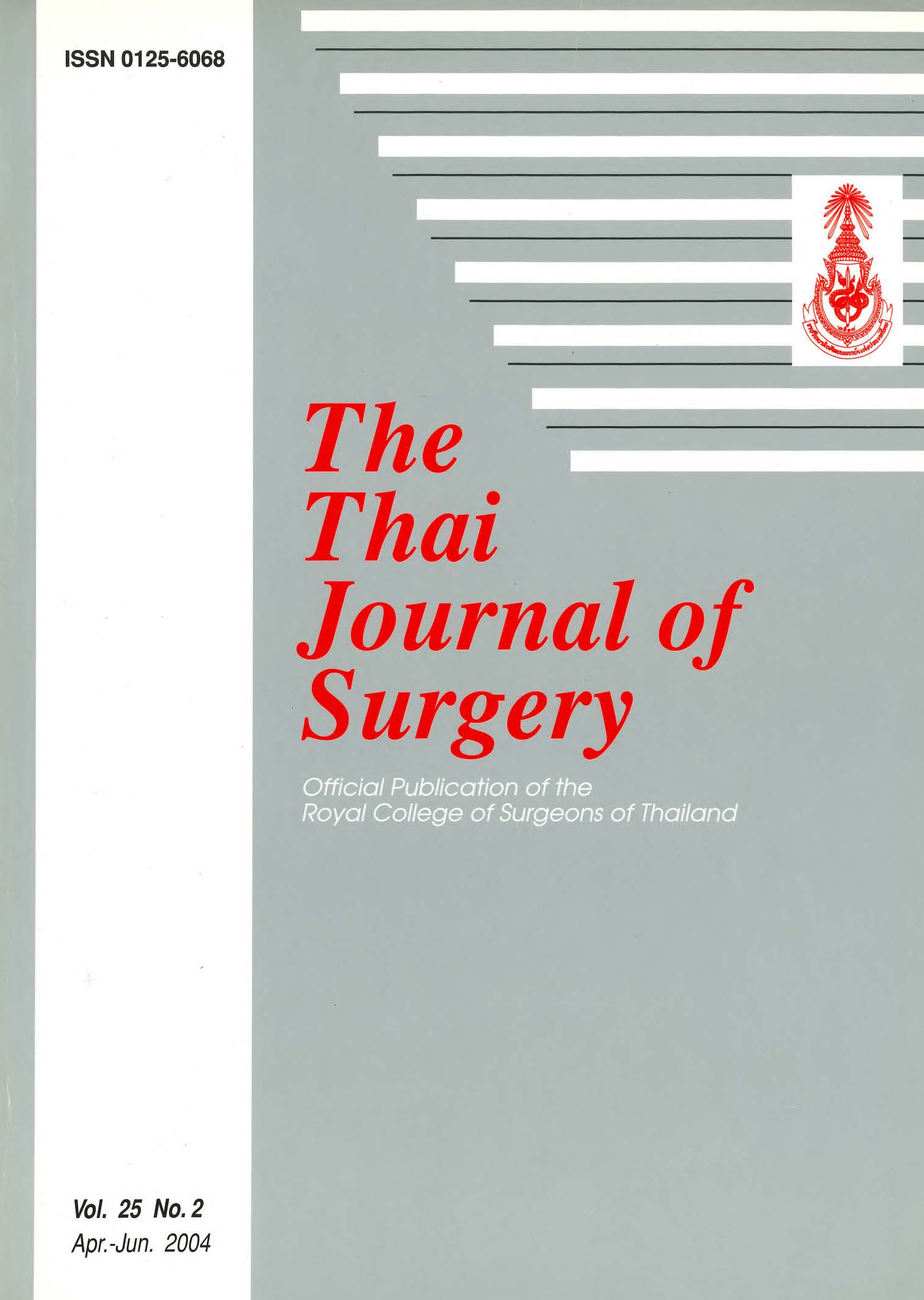Minimal Incision for Repair of Non-ruptured Infrarenal Abdominal Aortic Aneurysms
Abstract
Purpose: In this study we evaluated the clinical and economic impact of minimal incision aortic surgery (MIAS) for the treatment of patients with non-ruptured infrarenal abdominal aortic aneurysms (AAAs).
Methods: Fifty four consecutive patients with non-ruptured infrarenal AAAs were prospectively studied in three different surgical approaches. They were divided into 3 groups of 18 patients each. Patients in Group I were operated by minimal incision aortic surgery (MIAS) technique, Group II by the traditional long midline transabdominal approach (TPA) and Group III by the left retroperitoneal approach (RPA). Demographic characteristics including age, sex, body weight, aneurysm size, and comorbid risk factors of the three studied groups were compared using Fischer exact test. Parameters including operating time, intraoperative fluid administration, and transfusion requirements were compared using 2-tailed Student t test. Length of stay in the intensive care unit (ICU), time to resuming regular dietary feeding, and hospital length of stay were recorded and compared using Wilcox rank sum test. The incidence of 30 days postoperative complications and mortality were compared among the groups.
Results: There was no significant difference among the MIAS, TPA, and RPA groups regarding age, sex distribution, aneurysm size, or body weight. 'There was male sex prevalence in all three groups. Surgical exposure of the common femoral arteries was more commonly required in Group III (RPA) than in other groups. Although length of incision tended to be longer in Group III (RPA) than in Group II (TPA) and Group I (MIAS), but there was no significant difference in the operative time and aortic cross-clamped time among the three groups. There was a significant difference in intraoperative fluid needs, the most in Group II (TPA) and the least in Group I (MIAS). There was significantly less blood loss in Group I (MIAS) as compared with other two groups, but intraoperative blood transfusion for all groups was not significantly different. ICU stay, return to general dietary feeding, and hospital length of stay for Group I (MIAS) and Group Il (RPA) were significantly lower than those in Group II (TPA) which had higher incidence of postoperative ileus.
Conclusion: MIAS is as safe as retroperitoneal and standard transabdominal repairs in the treatment of non-ruptured infrarenal AAAs and may be also more cost-efficient than the retroperitoneal and standard transabdominal repair.
References
2. May J, White GH, Yu W, et al. Concurrent comparison of endoluminal versus open repair in the treatment of abdominal aortic aneurysms: analysis of 303 patients by life table method. J Vasc Surg 1998; 27: 213-20.
3. Jacobs TS. Won J, Gravereaux EC, et al. Mechanical failure of prosthetic human implants: a 10-year experience of aortic stent graft devices. J Vasc Surg 2003; 37: 16-26.
4. Creech O, Endoaneurysmorrhaphy and treatment of aortic aneurysms. Ann Surg 1966; 164: 935-46.
5. Laohapensang K, Pongcheowboon A, Rerkasem K. The retroperitoneal approach for abdominal aortic aneurysms. J Med Assoc Thai 1997; 80:479-85.
6. Lioyd WE, Paty PSK, Darling RC III, et al. Results of 1000 consecutive elective abdominal aortic aneurysm repairs. Cardiovasc Surg 1996; 4: 724-6.
7. Sriussadaporn S, Pak-Art R, Chiamananthapong S, et al. Surgery of the abdominal aorta: Experience of a University Hospital in Thailand. J Med Assoc Thai 2001; 84:1655-60.
8. Tassiopoulos AK, Kwon SS, Labropoulos N, et al. Predictors of early discharge following open abdominal aortic aneurysm repair. Ann Vasc Surg 2004; 18: 218-22.
9. Nakajima T, Kawazoe k, Komoda K, et al, Midline retroperitoneal versus midline transperitoneal approach for abdominal aortic aneurysm repair, J Vasc Surg 2000; 3:219-23.
10. Leather RP, Shah DM, Kaufman JL, et al, Comparative study of retroperitoneal and transperitoneal aortic replacement for aneurysm. Surg Gynecol Obstet 1989; 168: 387-93
11. Sicard GA, Reilly JM, Rubin BG, et al. Transabdominal versus retroperitoneal incision for abdominal aortic surgery. Report of a prospective randomized trial. J Vasc Surg 1995:21: 174-83.
12. Ballard JL, Yonemoto H, Killeen JD, Cost-effective aortic exposure; a retroperitoneal experience, Ann Vasc Sura 2000;14:1-5.
13. Hioki M, ledokoro, Y, Kawamura J, et al. Left retroperitoneal approach using a retractor to repair abdominal aortic aneurysms: a comparison with the transperitoneal approach. Surg Today 2002; 32: 577-80.
14. Sicunarine K, Lawrence-Brown MM, Goodman MA. Comparison of transperitoneal and retroperitoneal approach for infrarenal aortic surgery: early and late results. Cardiovasc Surg 1997; 5: 71-6.
15. Honig MP, Mason RA, Giron F. Wound complications of the retroperitoneal approach to the aorta and iliac vessels. J Vasc Surg 1992; 15: 28-33.
16. Gardner GP, Josephs LG, Rosca M, et al. The retroperitoneal incision. an evaluation of postoperative flank "bulge", Arch Surg 1994; 129: 753-6.
17. Kline RG, D' Angelo AJ, Chen MH, et al. Laparoscopically assisted abdominal aortic aneurysm repair: first 20 cases. J Vasc Surg 1998; 27:81-7.
18. Castronuovo JJ, James KV, Resnikoff M, et al, Laparoscopic - assisted abdominal aneurysmectomy. J Vasc Surg 2000; 32:224-33.
19. Turnipseed WD, Hoch JR, Acha CW, Carr SC. Less invasive aortic surgery: the minilaparotomy aortic technique. Surgery 2000;128:751-56.
20. Morishita K, Kawaharada N, Fukada J, et al. Can minilaparotomy abdominal aortic aneurysm repair be performed safely and effectively without special skills. Surgery 2003;133:390-5.
21. Turnipseed WD, Carr SC, Hoch JR, Cohen JR. Minimally incision aortic surgery. Ann Vasc Surg 2003; 17: 180-184.
22. Maloney JD, Hoch JR, Car SC, Acher CW. Turnipseed WD Preliminary experience with minilaparotomy aortic surgery Ann Vasc Surg 2000; 14: 6-12.
Downloads
Published
How to Cite
Issue
Section
License
Articles must be contributed solely to The Thai Journal of Surgery and when published become the property of the Royal College of Surgeons of Thailand. The Royal College of Surgeons of Thailand reserves copyright on all published materials and such materials may not be reproduced in any form without the written permission.



